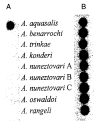General properties and phylogenetic utilities of nuclear ribosomal DNA and mitochondrial DNA commonly used in molecular systematics
- PMID: 10634037
- PMCID: PMC2733198
- DOI: 10.3347/kjp.1999.37.4.215
General properties and phylogenetic utilities of nuclear ribosomal DNA and mitochondrial DNA commonly used in molecular systematics
Abstract
To choose one or more appropriate molecular markers or gene regions for resolving a particular systematic question among the organisms at a certain categorical level is still a very difficult process. The primary goal of this review, therefore, is to provide a theoretical information in choosing one or more molecular markers or gene regions by illustrating general properties and phylogenetic utilities of nuclear ribosomal DNA (rDNA) and mitochondrial DNA (mtDNA) that have been most commonly used for phylogenetic researches. The highly conserved molecular markers and/or gene regions are useful for investigating phylogenetic relationships at higher categorical levels (deep branches of evolutionary history). On the other hand, the hypervariable molecular markers and/or gene regions are useful for elucidating phylogenetic relationships at lower categorical levels (recently diverged branches). In summary, different selective forces have led to the evolution of various molecular markers or gene regions with varying degrees of sequence conservation. Thus, appropriate molecular markers or gene regions should be chosen with even greater caution to deduce true phylogenetic relationships over a broad taxonomic spectrum.
Figures









References
-
- Abele LG, Kim W, Felegenhauer BE. Molecular evidence for inclusion of the phylum Pentastomida in the Crustacea. Mol Biol Evol. 1989;6:685–691.
-
- Aguinaldo AMA, Turbeville JM, Linford LS, et al. Evidence for a clade of nematodes, arthropods and other moulting animals. Nature. 1997;387:489–493. - PubMed
-
- Bachellerie JP, Michot B. Evolution of large subunit rRNA structure. The 3' terminal domain contains elements of secondary structure specific to major phylogenetic groups. Biochimie. 1989;71:701–709. - PubMed
-
- Ballard JWO, Olsen GJ, Faith DP, Odgers WA, Rowell DM, Atkinson PW. Evidence from 12S ribosomal RNA sequences that onychophorans are modified arthropods. Science. 1992;258:1345–1348. - PubMed
-
- Beaver PC, Jung RC, Cupp EW. Clinical parasitology. 9th ed. Philadelphia, USA: Lea & Febiger; 1984.
Publication types
MeSH terms
Substances
LinkOut - more resources
Full Text Sources

